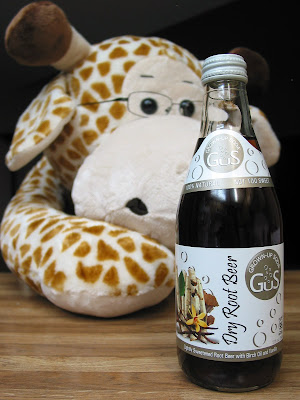The Pooj feels a chill.
(Rocket Fizz Camarillo, December 2011)So… Two posts in one week. What was I saying a couple posts ago about cutting down my sugar intake…?
Er, anyways, continuing our series on marginally seasonally-themed root beer, today we head to the North Pole and sample the resident beverages. Or is it the South Pole that has polar bears? I suppose it doesn’t really matter, since Polar Classics Root Beer doesn’t actually come from either Pole. Rather, JG Bieberbach of Germany first started the company – which he called the JG Bieberbach Company, naturally – in 1882 after moving to New York at the request of the Shafer Brewing Company to help brew the first true pilsner on this side of the Atlantic. After being sold to a liquor distillery in 1901 and acquiring a few more businesses here and there after that, the company, then known as the Bieber Polar Ginger Ale Company, hit Prohibition. Business thereafter was limited to seltzer, ginger ale and mineral water. Post Prohibition, they decided to remain a soft drink company and so remain to this day, operated by the fourth generation of the same family that purchased it back in 1901. Today, at least in its company website’s estimation, Polar Beverages is the largest independent soft drink bottler in US.
Jolly rotund men (and even dour svelte men, I suppose) of either Pole with a sweet tooth should enjoy Polar Classic Root Beer, as its dominant flavor is very sweet and caramel-y. Men (or women) of any predisposition and body type with a root beer tooth, however, might be a little disappointed, since the mild root-y flavor is really only around the edges of the sweetness. While it lacks any distinctive herb notes, it does have a decent amount of vanilla flavor and a pleasantly menthol aftertaste to round out the sweetness, though the sweetness is definitely the defining ingredient in the palette.
On a more positive note, the texture is very smooth. There’s a more-than-satisfying amount of foam that’s soft, with a glossy sheen that suggests the addition of a foaming agent. A quick glance at the ingredients shows quillaia extract, so we are go on the foaming additive. Said foaming agent also gives a slight acidity to the aftertaste, but not enough of one to bother me.
The Pooj feels an artificial chill.
Wait, how’s that again? Did someone say something about diet sodas?
Yeah, so feel free to throw out everything I wrote a couple posts ago. Except that part about the 30 bottles of root beer. Actually, throw that out, too – there’s closer to 40 now (I’ll explain later). In my defense, I actually couldn’t find the regular version of Polar Classics Root Beer for months, so had purchased the diet version beforehand, just in case. This will be the last time I make that mistake, I promise. Why such a reaction? Because when tasting the Polar Classics Diet Root Beer and the Polar Classic regular Root Beer side-by-side, the diet version really tastes like nothing at all.
First, there’s no smell coming from the bottle. None. Save for the slight smell of glue that wafts up when poured in a glass, there’s nothing to indicate that there’s anything in here at all. Granted, I’m sampling this after having just ingested the better part of a bottle of the super-sweet version, so by comparison, I would have been optimistic at best and deluded at worst (yes, I’m taking my root beer consumption a little too seriously, but hey, I have a blog devoted to it, so I think I’ve more than proven that point already…) to expect otherwise. That said, I would have at least expected the diet version of a beverage to taste something like the regular version (for the record, Diet Dr. Pepper doesn’t taste more like regular Dr. Pepper, unless when considering the statement “tastes more like regular Dr. Pepper than _____,” your “_____” is something unlike Dr. Pepper entirely, like say, gazpacho). Any “root beer” character is limited to the aftertaste, which is the same as that of the root beer chewing gum we spoke about a couple months ago.
Diet Polar does share one thing in common with regular Polar: the quillaia extract – the Diet Polar actually holds its head better than the regular Polar. However, possibly due to the lack of real sugar and the typically ensuing thin texture, the resulting carbonation is much harder and makes the overall beverage feel much less smooth than its sugared counterpart. Interestingly, the use of sucralose instead of aspartame as the artificial sweetener actually reduces the stinging feeling in the back of the throat that most other diet beverages suffer from – Diet Coke also uses sucralose (Splenda), but also has the sting, so I don’t know what’s different here.
But really, do we care? We’re here to talk real root beer, not fake root beer. As a real root beer, Polar Classics Root Beer isn’t bad, but not particularly memorable either. Penguins, polar bears, and red be-decked saints alike, we can probably do better. I give Polar Classics Root Beer a 3.



